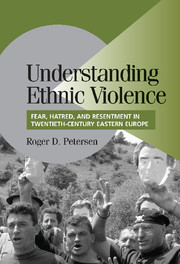Book contents
- Frontmatter
- Contents
- Preface
- 1 INTRODUCTION
- Part One Theory
- Part Two Comparisons: The Baltic States in the Twentieth Century
- 5 BALTIC 1905
- 6 IN THE WAKE OF BARBAROSSA
- 7 THE RECONSTRUCTION OF INDEPENDENT STATES
- 8 ACROSS THE CENTURY
- 9 CZECHOSLOVAKIA, 1848–1998
- 10 YUGOSLAVIA
- 11 CONCLUSION
- Bibliography
- Index
- Cambridge Studies in Comparative Politics
9 - CZECHOSLOVAKIA, 1848–1998
Published online by Cambridge University Press: 05 June 2012
- Frontmatter
- Contents
- Preface
- 1 INTRODUCTION
- Part One Theory
- Part Two Comparisons: The Baltic States in the Twentieth Century
- 5 BALTIC 1905
- 6 IN THE WAKE OF BARBAROSSA
- 7 THE RECONSTRUCTION OF INDEPENDENT STATES
- 8 ACROSS THE CENTURY
- 9 CZECHOSLOVAKIA, 1848–1998
- 10 YUGOSLAVIA
- 11 CONCLUSION
- Bibliography
- Index
- Cambridge Studies in Comparative Politics
Summary
We have become poor, but we are not miserable; we quarrel, but our passions do not fly; we throw eggs but not grenades; we are willful, but not without will.
Pavel Tigrid, Lidove noviny, December 1991The motivation for this chapter is the extraordinary change in ethnic group composition in Czechoslovakia over the past seventy years. When the First Czechoslovak Republic was formed in 1918, it was one of the most ethnically heterogeneous states in Europe. In fact, the Czechs held an absolute majority by only the slimmest of margins. By 1987, however, the ethnic composition of Czechoslovakia had changed dramatically. While Czechs and Slovaks saw their percentage of the population increase during this seventy-year period, the Russian, German, and Hungarian populations watched their numbers decline (see Table 9.1). Moreover, the level of ethnic homogeneity that has evolved in the territories of the former Czechoslovakia seems even more stark when one separates the Czech Republic from Slovakia. The data in Table 9.2 clearly illustrate the level of demographic dominance achieved by Czechs and Slovaks in their respective republics at the start of the 1990s.
At the same time, the Czechoslovak national character has been hailed – or lamented, depending on the point of view – as tolerant and passive. In demonstrating tolerance, scholars tend to adopt a beneficent view; often they describe Czechoslovakia as having the longest functioning interwar democracy and as taking extra measures to protect its minorities.
- Type
- Chapter
- Information
- Understanding Ethnic ViolenceFear, Hatred, and Resentment in Twentieth-Century Eastern Europe, pp. 175 - 207Publisher: Cambridge University PressPrint publication year: 2002



